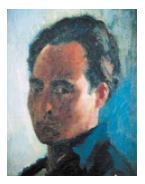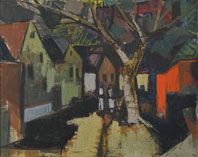INVITATION
Biography
Zoltán Nuridsány was born on 22
August 1925, in Marosvásárhely, of Szekler origin on
his mother’s side and Armenian on his father’s side.

In Budapest, at the Cistercian St. Imre High School,
under the guidance of graphic artist Nándor Nagy, he
became a regular member of the Fine Arts Circle. He
also regularly draws at Tibor Gallé’s famous Free
School, where he deals with the proportions and
dynamics of the human body.
This conscious preparation won him admission to the
Academy of Fine Arts in 1944. His masters were István
Szőnyi, Jenő Barcsay, János Kmetty and Géza Fónyi in
the mosaic department.
Durig the spring of 1945 he works in Szentendre in the company of Jenő Barcsay and János Kmetty.
From 1946 he participates in exhibitions at the European School. His critics considered him as a member of the new generation of the European School and as an Academy of Fine Arts student of an earnest and promising talent.
In 1948, he was a scholarship student of the Collegium Hungaricum of Rome. His exhibited works gained great success at the scholarship holder’s exhibition. The colours and forms he used drew the attention of a number of Italian art magazines authors who compared his talent to other great European artists. Under the known political circumstances, Szőnyi helped his talented students with this scholarship to escape to Italy. However, for Zoltán Nuridsány, resettling from Transylvania at the age of 11 was such a traumatic experience that he did not wish to relive.
Back in Hungary, he was greatly
concerned with the theoretical and practical problems
of mural art upon the initiative of Máriusz
Rabinovszky, whose assistant lecturer was Zoltán
Nuridsány. In 1949, a monumental mosaic sketch was
exhibited at the MEFESZ (Hungarian Association of
University and College Students) Exhibition. His
talent was praised by Lajos Fülep as well.
In 1949–50, the ’Quadriga’ was founded by Ferenc Jánossy, Zoltán Nuridsány, Gellért Orosz, and Gyula Sugár. Their exhibitions met with warm response in the early fifties, but as János Frank wrote: „The Quadriga started to make progress, but the socialist realism stopped it” (Frank, 1992). In 1955 the Quadriga had five new members: painters László Bod, Lipóth Böhm, László Bornemissza and sculptors Barnabás Megyeri and László Wágner.
In 1955, Nuridsány’s first – and last
– monumental work was created the “Engineer” (a mosaic
with a couple of figures) on the outside wall of the
Engineering School in Székesfehérvár. The next tender
arrived two decades later not long before his death.
His project was rewarded twice, but the third time his
project was not the award-winning one. Moreover, his
project has never been implemented.
In the meantime he became famous for his paintings.
In 1962, he had his solo exhibition, which was held in the Fényes Adolf Gallery. The text of the catalogue was written by János Frank.
In 1962, he visited Vietnam due to his wife’s job, where he spent six months. In November, he exhibited his prints and aquarelles mostly made in Vietnam, titled Hanoi–Haiphong–Budapest, which gained great success. On their way back home, they spent a month and a half in China and a month in the Soviet Union. visiting the major cities and historical sites.
In 1966, In Szeged, his works were exhibited alongside the works of Erik Scholz and Gyula Sugár, which was inaugurated by László Bod.
In 1968, a collection of drawings
with the title “Vietnam in pictures” was exhibited.
His paintings have been selected in
numerous national exhibitions, most notably the annual
Art Gallery of the Kunsthalle and the Ernst Museum. In
the discussion of ’Life and Literature’ (a weekly
Hungarian magazine about literature and politics)
about the 1957 Spring Exhibition, György Szabó
referred to his work as one of the promising future
talents. Each exhibition of his gained great success.
His works now belong to the Hungarian
National Gallery, to other museums in the country and
also to the collections of Hungarian and foreign art
collectors, and in homes.
Apart from his atelier in the Alkotmány Street, he also enjoyed painting at artist’s colonies among many others in Szentendre, Sárospatak, Vörösberény, Nagymaros and Zsennye.
In his last years he even visited Armenia and received his first passport to the West (to the other side of the Iron Curtain), to France. In Paris, among other, he met Tibor Csernus, Simon Hantai, Pál Hargitai and Judit Reigl, who had tried unsuccessfully to send him an official invitation in the previous decades. He was delighted to meet them, but because of his illness he could no longer plan anything, even though Michel Gyarmathy offered him a job as a stage-designer.
On 22 May 1974, in Debrecen, while he
was preparing his next exhibition, the sudden death
came in the prime of his life.
